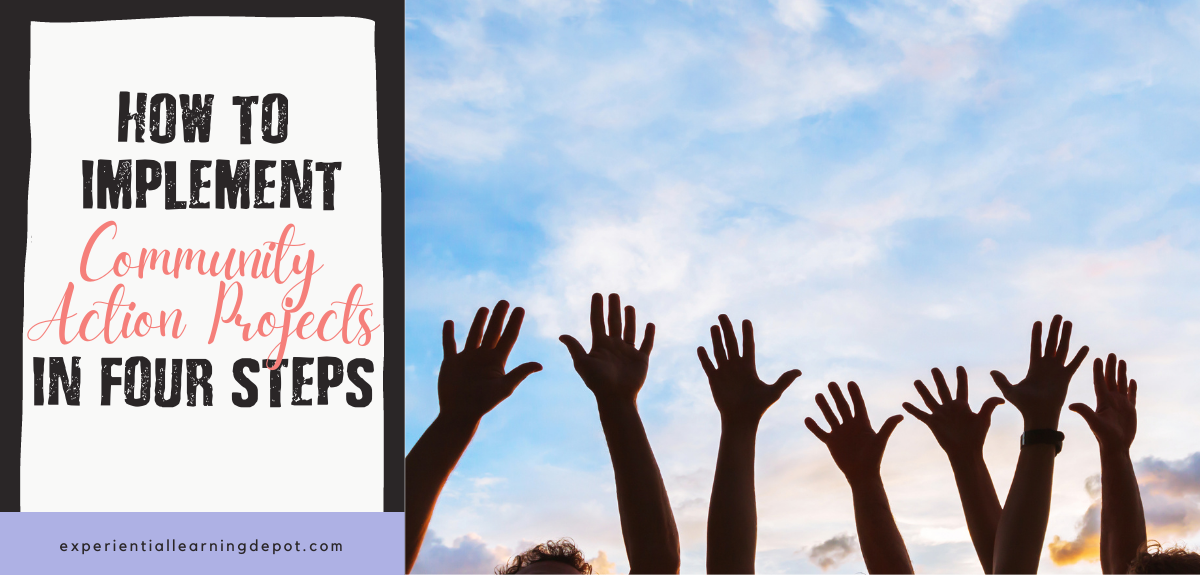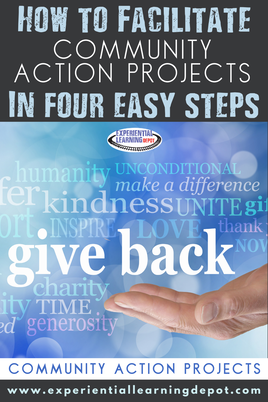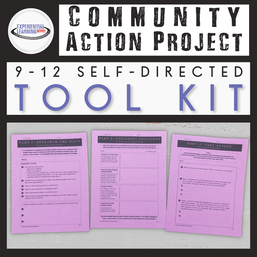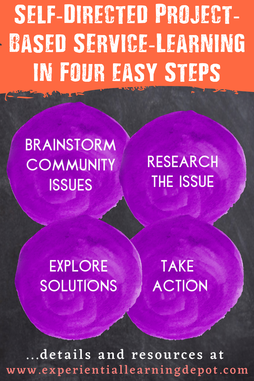|
Experiential learning resources for the innovative educator
When I was teaching high schoolers, I included community action projects in every facet of my teaching. A community action project is a form of project-based learning where students identify issues in the community, research the issues, brainstorm solutions, develop an action plan, and take action. These experiences are the coolest form of self-directed service-learning.
I would often assign a community action project to my class around a theme such as "invasive species" (I am a science teacher). My advisory students also complete community action projects as do my seniors.
I do this because community action projects deepen learning AND build essential 21st-century skills such as collaboration, problem-solving, empathy, team-work, critical thinking, and so much more. The benefits are enormous.
The trick comes in implementation. These projects require independence and self-direction. They also push students out of their comfort zones, which is a great thing for so many reasons, but it can also create some resistance. Avoid these challenges by having a seamless facilitation plan. That is the purpose of this blog post.
Before reading on, click the button below to grab my free experiential learning activities implementation spreadsheet, including a page specifically for community action projects. Add the steps below into your calendar to coordinate and execute the most amazing, life-changing project-based service-learning projects. Project-Based Service-Learning in Four Easy Steps
Project-based service-learning experiences, or my "community action projects", take time. My students take anywhere from 3-6 weeks to complete their projects. Project-based learning is sustained inquiry, which requires deep exploration. That is the point, and that is the benefit of an experience like this.
Don't start an experience like this unless you can commit to the details. It's worth it! So let's dive into the details here so that you can see what the steps are and why they are time-intensive
1. Brainstorm/Identify Community Issues:
This is arguably the most important step of a community action project. Students identify their interests, make observations about their communities, and decide on a general direction to take the experience. Whether students are choosing their own topics or subtopics from a theme, students will need to do some digging to figure out what sparks their interest and what matters to them personally. I do this by having students explore current events, complete interest surveys, discuss community issues, and more.
2. Research the Issue:
Once students have settled on a community issue that they would like to tackle, they research the issue more thoroughly. The purpose of this step is to ensure that students make informed action plans. I have students complete a research style project-based learning experience. They write questions about the topic that they would like to explore further, research those questions, and create an innovative final product to demonstrate learning before moving on. All of my community action project resources include this step. Students move through a series of guiding templates, including researching the issue. Give students at least a few days to explore the issue. My students present their final products to me and the class before moving on to the next step.
3. Explore Solutions and Write an Action Plan:
Once students have explored the issue thoroughly they can begin to brainstorm solutions to the problem. This phase of the experience involves throwing out action ideas. There are a variety of ways that students can take action. Last week's blog post is about this step. Go check out "Four Ways Students Can Impact the Community Through Project-Based Service-Learning" for specifics. I give my students a graphic organizer with these four action options listed. Students then dump a variety of ideas onto the page. They work through their options to determine which action ideas are the most realistic to execute, the most interesting and meaningful to the student, and those that will make the biggest impact. Then they choose their course of action. This phase of the experience could take a couple of days. It is important that students have time to reach out to community members, explore and identify other efforts in place, and more. All of the pieces of this phase are included in my community action projects as well.
4. Take Action:
At this point students carry out their action plans. Every step so far carefully and seamlessly leads your students here. Before moving onto this phase students should have explored the issue intensively, brainstormed and settled on an action plan, and made the arrangements necessary to execute the action plan. Once all of that is in place they can take action. This is where students go off on their own. If a student has arranged to start a supplies drive for a local animal shelter, for example, it is their responsibility to get fliers or social media posts out there, to put a supplies drop-off system in place, and to get the supplies to the shelter. It is not your job to drive your student and the supplies to the receiver . Your job is to put check-ins in place, offer consistent feedback, implement a reflection piece, offer opportunities for students to make adjustments to their plans, and more. Again, use the free planner for these important facilitation strategies. And again, my community action project resources include templates for students to make very clear and intentional action plans.
I hope this step-by-step guide has been helpful, and as always, reach out to [email protected] with questions.
Follow Experiential Learning Depot on Pinterest and Instagram for more on experiential education. Observe. Question. Explore. Share.
2 Comments
Sara Segar
1/5/2021 10:41:16 am
Thank you, Wayne!
Reply
Your comment will be posted after it is approved.
Leave a Reply. |
Blog IntentTo provide innovative educational resources for educators, parents, and students, that go beyond lecture and worksheets. AuthorSara Segar, experiential life-science educator and advisor, curriculum writer, and mother of two. Categories
All
|







 RSS Feed
RSS Feed